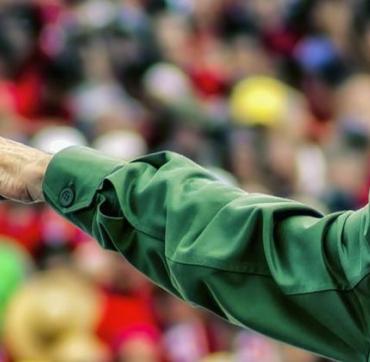The Hundred Years of the Maestro
especiales

Ramiro Guerra would be a hundred years old today. He would turn a hundred, he turns them. Because that’s what the great masters have: they eternalize their contributions.
When speaking about dance in Cuba there are essential names: the three Alonsos: Alicia, Fernando, and Alberto. and Ramiro. Ramiro among many. Ramiro at the fore front of many. Ramiro opening a path. Ramiro Guerra giving birth to what would be a great movement in Cuban culture.
No wonder there’s absolute agreement: Ramiro Guerra is the father of modern Cuban dance. And he is a benchmark for dance in Latin America.
One may think of Ramiro's achievement and now we could naturalize it. But you have to be in his shoes: mid-twentieth century, someone who abandons law school to pursue a dubious career, someone who wants to dedicate himself to making art (which is already known to be a generally low-paid job) and also chooses an art that’s practically unknown in these parts: modern dance, the one that broke with the more or less rigid stereotypes of ballet, the one that deviated from the canons of the popular standard to reinvent the logic of movement.
Ramiro had that strength, that courage. He faced prejudice and embarked on a real adventure. He was linked to the emerging Cuban ballet and (as Alicia and Fernando did at the time) he ended up traveling to the United States, to get closer to what for many was the pinnacle of modern dance: Marta Graham.
He returned to Cuba. And he had the chance of a winning Revolution.
1959 was a turning point for the entire nation. He led a new era, across the board. Never before had culture been given a functional role in the social intertwine.
1959 was a founding year. The creation of the National Theater of Cuba, directed by Isabel Monal, was a shelter for several projects. Ramiro found his sounding box there.
The creation of a modern dance company was a collective effort, but Ramiro Guerra had an indisputable leadership. He started from a base, acquired in the years of learning from him, but understood the need to establish new frameworks.
To the creation of a new technique, a new way of taking up dance, a new spirit... reached, more than a restless man, a cultured man.
Ramiro Guerra knew how to articulate a creative impulse. He drank from the heritage of his people (particularly his African roots, in dialogue with a Hispanic heritage) and recreated a tradition.
Some of his essential works are from those early years: Yoruba Suite, Medea and the slavers... that ability to make multiple cultural references converge was extraordinary.
The contradictions of a process set obstacles. The frustrated premiere of the Decalogue of the Apocalypse, due to the misunderstanding of certain decision makers, marked a new stage in a complex era for Cuban culture.
Some believe that the choreographer's career suffered a crushing blow (although over the years the teacher proposed new creations); but for others, that "escape" (he abandoned his responsibilities at the head of the Modern Dance Ensemble) represented a new stage.
From his voluntary and relative isolation, Ramiro Guerra saw a novel approach (at least in his context) to dance theory.
He was definitely one of the most active essayists of Cuban art. And his contributions go beyond dance itself. Ramiro was a full intellectual. His imprint can be traced in the entire body of Cuban culture.
In one of his last interviews, published on this website, he stated: «Ramiro, Ramiro, Ramiro… My mark is everywhere. Not only in Contemporary Dance or in Folkloric. In all the companies in Cuba there’s a bit of me. I had many students and my relationship with them has always been complex, a love-hate relationship, but there they are, they are the people who have made dance in Cuba».
That is, ultimately, the greatest contribution: the strength and implications of a teaching profession. A century after his birth, Ramiro Guerra still has much to teach.
Translated by Amilkal Labañino / CubaSí Translation Staff














Add new comment